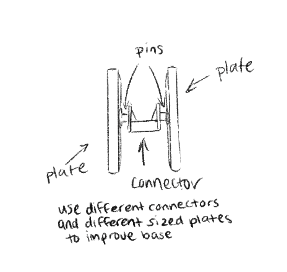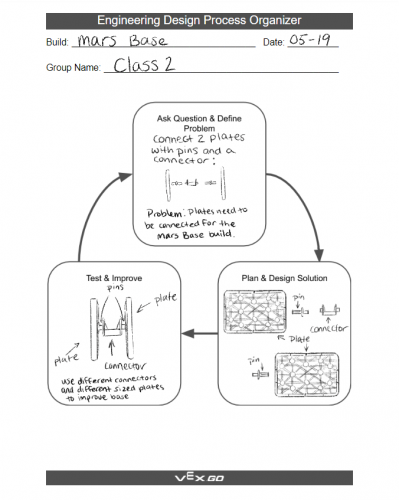Play
Part 1 - Step by Step
- InstructInstruct groups that they will design and build a base for Mars. The base should protect the Astronaut from the environment while providing enough space for them to move around.
- Instruct students that they can build any design that they want, the only constraint is that they can only use pieces from the VEX GO Kit (minus the electronics) to build their Mars Base.
- Each group should use their Engineering Design Process Organizer to plan their build.
- ModelModel for the students how to sketch and build using an Engineering Design Process Organizer from the materials list.
Demonstrate the following for students if necessary:
- Connect two plates with a connector and pins.
- Sketch an example build using a whiteboard or an Engineering Design Process Organizer.
- Ask students to identify which pieces you used. Where are they on the sketch?
-
Draw an arrow to each piece on the sketch and write the name of the piece next to the beginning of the arrow.

- FacilitateFacilitate the building process by circulating around the room. Encourage a discussion by asking the following questions:
- How many pieces are you using in your design?
- Why did you put this piece above that piece?
- What kind of shape does your Mars Base resemble?
- Which pieces are the largest in your design? The smallest?
- Why did you choose this piece here? (Point at a specific piece in their diagram).

- RemindRemind groups to document their designs on their Engineering Design Process Organizer and to be strategic with the pieces in the GO Kit. Continually refer to the criteria and constraints so that groups do not run out of materials.
- AskAsk students how the Astronaut’s needs will be met by features in the design.
- Should the base be enclosed?
- How will the Astronaut get in and out?
- What will they be able to do inside?
Mid-Play Break & Group Discussion
As soon as every group has finished their first build, come together for a brief conversation.
Students will share and discuss their builds with the rest of the class. In doing so, students can obtain peer feedback on their designs, that can be applied during Play Part 2 to make additional edits to their builds.
- Describe the layout of your Mars base.
- Where is the entrance located?
- What areas do you have created?
- What pieces did you use from the VEX GO Kit and why?
- Why did your group choose a standoff instead of a pin? (or vice versa)
- What makes a plate a better choice than a beam in this part of your design?
- How are the Astronaut’s needs being met by features in the design?
- What pieces make this Mars base enclosed?
- How do you know if your base is stable?
- How can you improve the design?
Part 2 - Step by Step
- InstructInstruct each group that they will use ideas from the discussion to revamp their design. Instruct students to first discuss their ideas as a group and document their planned changes in their Engineering Design Process Organizer. Encourage them to use spatial language to explain their ideas.
- ModelModel going back into the Engineering Design Process Organizer to sketch ideas. Demonstrate taking pieces off or otherwise moving pieces around the Mars base build to modify a design. This demonstration can be done with physical pieces from the VEX GO Kit or by sketching designs onto a whiteboard or Engineering Design Process Organizer to show how designs can change.
Groups may want to deconstruct their build at this point. Encourage them to "modify" not "rebuild" if completing the Lab in one session.

- FacilitateFacilitate groups making edits to their build by circulating and asking groups to describe the changes they are making (using spatial language). Encourage a discussion by asking the following questions:
- How will these changes will improve the build and serve the Astronaut?
- What feedback did you take from the discussion with other groups?
- Did you like anything from another group’s design that you wanted to use on yours?
- RemindRemind groups to make sure the first priority for improvements is to better serve the Astronaut and meet the design criteria.
Explain to groups that all of the feedback and recommendations they received may not be able to be implemented and that is okay. Groups may only have materials and time to implement one or two changes to their build.
- AskAsk students what changes they made and why.
- Would they have made more changes if they had more pieces? If so, what additional changes would they make?